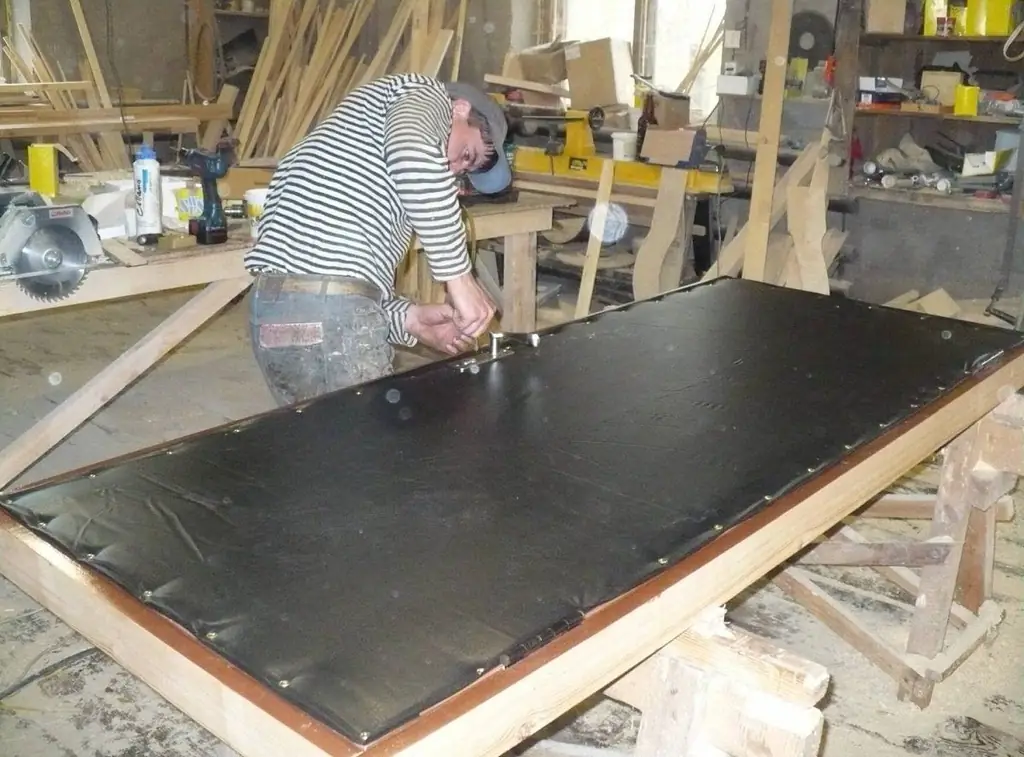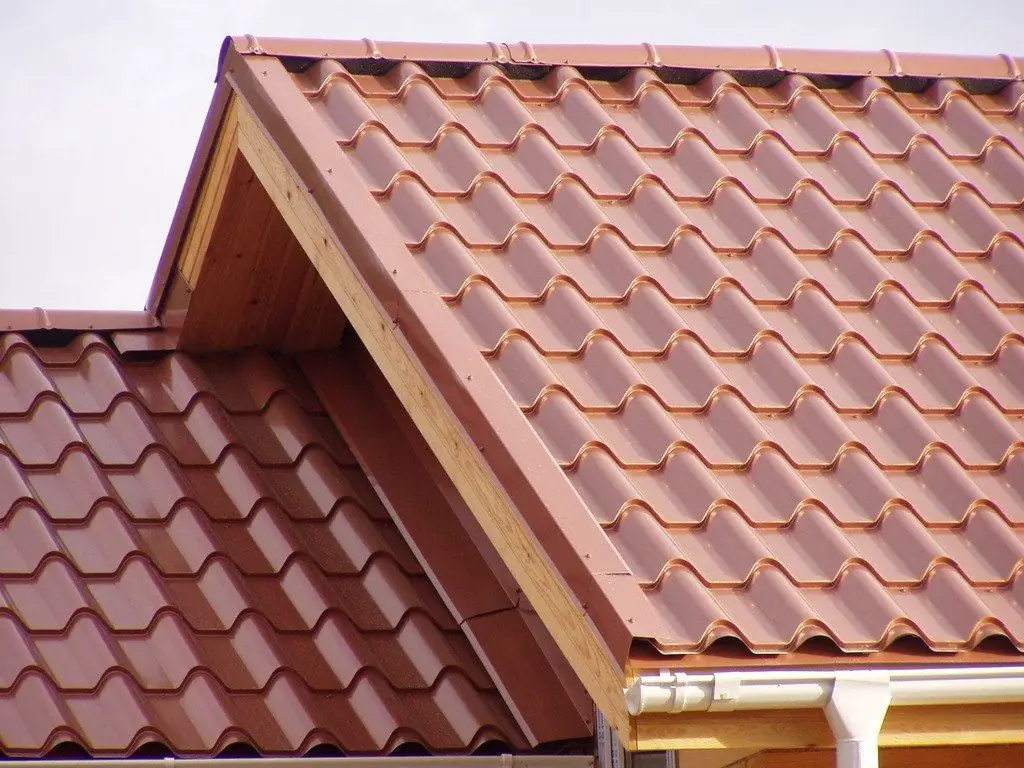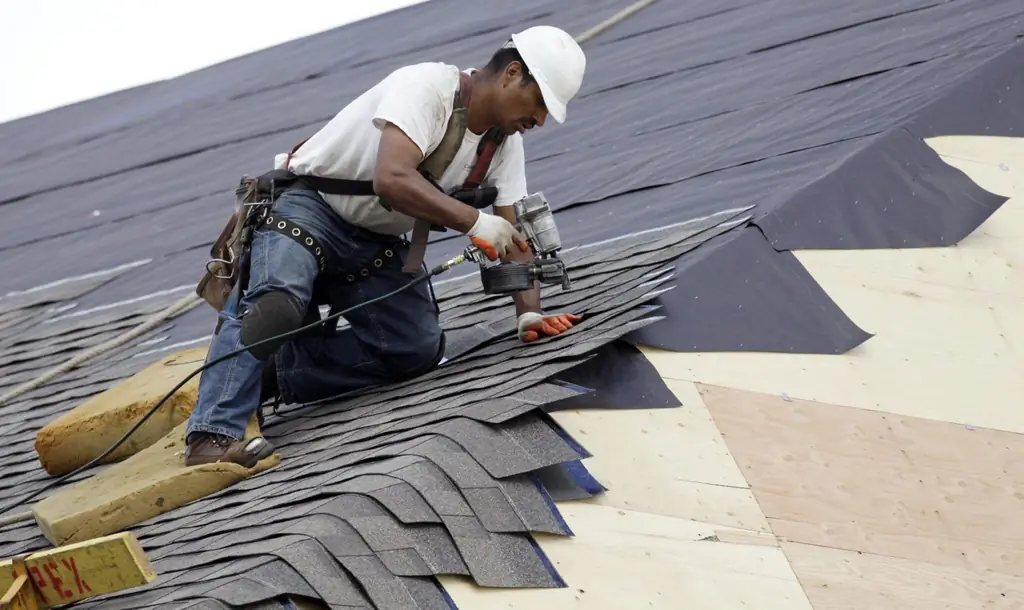
Table of contents:
- Author Bailey Albertson [email protected].
- Public 2023-12-17 12:53.
- Last modified 2025-06-01 07:32.
How to upholster doors with leatherette yourself

One of the options to insulate the front door and change its appearance is leatherette upholstery. Someone might say that this is an old and forgotten method, but this is not entirely true. This technology is still quite popular, because it allows you to get the desired result quickly and inexpensively. In addition, leatherette upholstery helps to improve the soundproof characteristics of the canvas, and even a beginner can do such work with his own hands.
Content
-
1 What is leatherette
1.1 Recommendations for choosing leatherette
- 2 Tools and materials
- 3 Preparatory work
-
4 Methods for upholstering doors with leatherette
-
4.1 The traditional way
4.1.1 Video: upholstery of a wooden door in the traditional way
- 4.2 Tiled method
- 4.3 Using a frame profile
-
4.4 Metal door trim
4.4.1 Video: metal door trim
-
- 5 Expert advice
What is leatherette
The leatherette has a cotton base, on one or both sides of which a nitrocellulose coating is applied. On sale you can find material of different thickness, density, texture and color.

For door upholstery, you can choose leatherette of the desired color and texture
It is usually customary to sheathe entrance doors with leatherette, but this material also looks impressive on interior canvases, the main thing is that it is in harmony with the interior of the room. Dermatin does not lose its popularity and demand due to the presence of the following advantages:
- high moisture resistance. It repels moisture well, does not accumulate it and protects a wooden or metal sheet, as well as used thermal insulation materials;
- long service life. This material retains its original characteristics for 8-10 years, and if it is properly looked after, even longer;
- ease of care. To clean and renew the surface of such a door, it is enough to periodically wash it with soapy water and lubricate it with a special cream;
- high resistance to ultraviolet light. The fact that this upholstery material does not fade in the sun allows it to be used for finishing doors outside;
- good frost resistance. Even at low temperatures, leatherette retains its original characteristics;
-
large selection of colors;

Types of leatherette There is a large selection of both smooth and corrugated leatherette
- resistance to biological and chemical influences. This material does not rot, is not damaged by fungi and mold. If necessary, it can be cleaned with household detergents;
- high heat and sound insulation characteristics;
- beautiful appearance. Doors upholstered with leatherette stand out favorably against the background of ordinary wooden or metal canvases;
- affordable cost.
It has leatherette and a number of disadvantages:
- instability to mechanical damage;
- flammability. This coating spreads fire well. For entrance doors upholstered with leatherette, fires and arson are dangerous;
- low maintainability. If the leatherette is cut or torn, it is no longer possible to repair it, you will have to upholster the doors with new material.
Recommendations for choosing leatherette
When choosing, you need to pay attention to the following characteristics:
-
Upholstery color. This is one of the main factors, since the doors must harmoniously fit into the surrounding interior. If the inner side is upholstered, then the color of the material is matched to the rest of the doors, furniture or floor. When finishing the outer side of the canvas, dark colors are usually chosen that do not get dirty so quickly. Leatherette in bright and rich colors will help highlight the door, but it will need to be regularly looked after. It is not necessary to use the same color material on both sides. If you will upholster a street door, it can be decorated in the tone of a porch, windows or roof.

Leatherette colors A large selection of leatherette colors allows you to choose the door trim for the environment
- Lighting. The same material will look different at different light intensities.
- Design style. Leatherette can be smooth, have vertical or horizontal embossing, various patterns and abstract designs, or be stylized as natural leather. In addition to choosing the texture of the material, one must remember about the possibility of decorating the doors by creating a pattern using upholstery nails. To improve the relief of the pattern, several layers of foam rubber must be placed under the leatherette.
-
Strength. If there are animals in the house, there is a high risk that they can damage the soft upholstery of the door. Even the highest quality leatherette cannot resist the claws and teeth of dogs, but if you have a cat, it is better to choose a material with increased strength. As for frost, even the cheapest leatherette is not afraid of it and will not crack at low temperatures.

Damage to leatherette If the leatherette is cut or torn, it is no longer possible to repair it
- Elasticity. The material should be resilient but not stretchy like rubber.
- Smell. If it is clearly felt, then one should not hope for its disappearance over time. Indoors, such material cannot be used; if desired, they can upholster the doors from the outside.
Tools and materials
To upholster a door with your own hands, you need to have simple tools that every home craftsman usually has:
- knife, it is better to use a clerical;
- a hammer;
- stapler;
- scissors;
- pliers;
- measuring instruments;
- a set of screwdrivers or screwdriver;
-
brush (for finishing metal cloth).

Leatherette door upholstery tools To upholster the door with leatherette, you need simple hand tools
In addition, you need to prepare all the necessary materials:
-
upholstery fabric. When buying a leatherette, one must remember that its dimensions should be 10-15 cm larger than the dimensions of the door along its length and width. When upholstering a wooden canvas, you will need strips of material 12-15 cm wide, from which the rollers will be made. They can be bought ready-made, and they can be either in tone with the main coating or in a contrasting color;

Leatherette A piece of leatherette should be 10-15 cm larger than the size of the door leaf
-
lining material. Usually used foam rubber 1-2 cm thick. To obtain higher heat and sound insulation characteristics, you can use Izolon;

Foam rubber Foam rubber is usually used as a lining material.
-
furniture buttons;

Furniture buttons Furniture buttons are used to create embossed door trim
-
upholstery nails. Decorative nails with a wide head are used to fix the leatherette. The best option would be if the color of the hats matches the shade of the handles and the lock. You can buy nails in which the caps are covered with leatherette. They can be taken to match the main upholstery or use a contrasting solution;

Upholstery nails Upholstery nails are used to fix the leatherette.
- glue. It will be needed to attach the upholstery to a metal sheet. Usually, for these purposes, use the glue "Moment" or any other with similar characteristics;
- decorative cord. Required for decorating upholstery. Instead, you can use metal strings or strips made of upholstery material;
-
one-sided frame profile.

Frame profile The frame profile is used for fastening and uniform tension of the leatherette
Preparatory work
Before the direct installation of leatherette, it is necessary to carry out preparatory measures:
-
Dismantling of fittings that will interfere with the work. They remove signs, peephole, handles, locks and other elements.

Dismantling fittings All fittings are removed from the door, which will interfere with the work
- Removing old upholstery. If the door already has leatherette or other upholstery, it must be dismantled.
- Dismantling the door. It is much easier, better and faster to perform work on a removed door. The dismantled canvas is laid on a table or on another support - for example, you can use 4 stools or chairs. If it is not possible to remove the canvas, it is also possible to upholster it, but it will be more difficult to work.
-
Inspection of the condition of the door. If mold or large cracks are detected on a wooden door, then these places are treated with special preparations, and the cracks are covered with adhesive sealant. The centers of corrosion of the metal surface are cleaned from rust and painted. Small flaws in the form of minor chips and cracks do not need to be eliminated, since they will be hidden by leatherette.

Preparing the door Large cracks are covered with a special putty or adhesive sealant
Methods for upholstering doors with leatherette
There are several options for fixing the material on the door leaf.
Traditional way
For the upholstery of the inside of the door, the sequence of work will be as follows:
-
Preparing the rollers. Their number will depend on which way the door opens. If outside, then you need four pieces, if inside - three. The size of the rollers is selected in accordance with the width or height of the door, depending on which side they will be installed on. The width of the roller should allow the foam rubber to be laid inside it.

Dermatine rollers Leatherette rollers can be made by yourself or purchased in the store
- Installation of rollers. They are applied along the perimeter of the door leaf and fixed with a stapler. The overhang of the stripes outside the canvas should not be more than 4 cm.
-
Installation of insulation. The material is cut to the size of the door, taking into account that it is located between the rollers, and fastened with brackets.

Installation of backing material Batting or foam rubber is laid on the canvas and fixed with a stapler
-
Installation of leatherette. The prepared section is folded on one side by 5-6 cm and applied to the canvas. The turned-up edge should slightly overlap the roller, and not fit close to it. The upholstery is fixed with decorative nails, which are nailed in 10-12 cm increments. Thus, the material is fixed on all sides of the door.

Installation of leatherette The leatherette is fixed with upholstery nails with a pitch of 10-12 cm
-
Decorative finishing. For a more beautiful result, you can make an individual pattern using special nails and a cord or string. To do this, they create a projection of the pattern on the canvas, then nails are nailed along its contours, and a cord or string is pulled between them.

Patterns for decorative door upholstery On the door, upholstered with leatherette, you can apply a pattern using a cord or string
Installation of leatherette from the outside of the door leaf is performed as follows:
- Designate the projection of the box on the door. To do this, close it and draw a line so that when sheathing the canvas it does not go beyond it.
- Attach the roller from below. With the door closed, it should fit snugly against the box.
-
The rollers are fixed at the top and sides. In contrast to the interior trim, here the rollers are attached to the door frame. They must be pulled out to such a distance that they well overlap the existing slots.

Fixation of rollers From the outside of the door, the rollers are attached to the door leaf
- Installation of insulation and leatherette. Their fastening is carried out by analogy with carrying out work on the inside of the door.
Video: upholstery of a wooden door in the traditional way
Tiled way
This is more difficult work, but the result is very beautiful. The upholstery process consists of the following steps:
-
Layout of the canvas. Using measuring tools, the canvas is marked out into identical rhombuses.

Canvas markup The marking of the canvas into rhombuses is performed using a square and a ruler
-
Fastening furniture buttons. In the corner of each diamond, the lower parts of the buttons are fixed with glue. With their help, the lining and upholstery material will then be fixed. After this, work must be stopped for a day so that these elements are securely fixed.

Parts of a furniture button The lower parts of the furniture buttons are attached to the door leaf, and then using the upper parts, the upholstery material is fixed
-
Preparing holes for insulation. They are made in accordance with the markings of the canvas on which the furniture buttons are installed. Then the foam rubber is fixed on the door with a stapler. You can not do this, because then he will be pressed with leatherette.

Preparation of insulation The holes on the insulation are made in accordance with the applied markings
- Preparation of leatherette. It is cut into rhombuses, which should slightly exceed the dimensions of the marked figures. The surplus will bend. For the convenience of doing the work, one corner on the leatherette rhombuses must be cut off.
-
Installation of finishing materials. Work begins at the bottom or top edge of the door. The lower part of the tiles is fixed with a stapler, while the cut corner is placed on top. After that, the excess edges are folded so that there are no distortions. The edges of the tiles are fastened with furniture buttons. As a result, each flap is securely fixed on four sides. Having laid the first row, they move on to the second and carry out the work until the entire surface of the canvas is covered with dermatine rhombuses.

Installation of rhombuses Dermatine rhombuses are laid according to the markings made, after which they are fixed to the canvas
Using a frame profile
In this case, the work is done in this order:
-
Door leaf markings. Determine the points at which the buttons will be installed.

Door leaf markings Mark the points at which the buttons will be installed
-
Fastening the frame profile. You can buy it at any furniture store. The frame profile ensures an even tension of the upholstery material. Profile elements are fixed along the contour of the door leaf with glue.

Fastening the frame profile The frame profile is fixed along the perimeter of the door with glue
- Fastening the lower parts of the buttons. This is done in accordance with the selected pattern.
-
Installation of insulation. Before this, they mark the places in which the furniture buttons will be installed, and make holes in them.

Insulation laying Holes are made in the places where the buttons are installed on the insulation
-
Installation of leatherette. Holes are also made in it in accordance with the selected pattern and applied to the foam rubber. Then the upper parts of the furniture buttons are twisted, the leatherette is pulled and tucked into the frame profile.

Laying leatherette The leatherette is fixed with furniture buttons, and the edges are tucked into the frame profile
- Installation of fittings. Handles, a lock, a number plate, a door peephole and other elements are attached to the canvas, after which it is hung on the hinges.
Metal door trim
The work is done in a similar order, but there are several peculiarities:
- Glue is applied to the canvas, after which the lining material is laid.
- After secure fixation of the lining material, a layer of glue is again applied to it and leatherette is applied. The edges of the material must be tucked up.
Video: metal door upholstery
Expert advice
After a while, the leatherette may lose its original appearance, as abrasions appear on it. If they are insignificant, then you should not rush to change the upholstery, as its appearance can be restored.
Staining leatherette is a simple and affordable way to restore the appearance of a door. For this, acrylic paint or special paintwork materials for leather are usually used. You can choose the desired tone by mixing several colors.

Leatherette can be painted with acrylic paints or special dyes for leather
Before staining, the leatherette must be cleaned of dust and dirt and degreased. You can apply paint with a brush or foam roller. The second coat is applied after about 20-25 minutes.
Sometimes there are situations when the leatherette was stored in a roll for a long time, which is why folds appear on it. Use water and a piece of cloth to smooth the material. Spread the leatherette, take a piece of cloth soaked in water and put it on top. As the fabric dries, the wrinkled fabric will begin to smooth out.
You can lay the wrinkled area face down and iron the fabric through a damp cloth at the lowest temperature. If there is a steaming function, then the fabric can not get wet.

Smooth the leatherette with an iron and a damp cloth
Leatherette upholstery can be done even by a novice home craftsman. This is a fairly simple and interesting job that only requires your desire and a simple set of tools to complete. By choosing such a solution, you can not only transform the appearance of the door and insulate it, but also improve the sound insulation characteristics. So you can create a unique author's design of the door leaf, which will effectively stand out against the background of other apartments.
Recommended:
Sheathing (upholstery) Of Doors: The Choice Of Material For Finishing, Tools And Stages Of Work

In what cases is door trim necessary. Materials used to cover doors. A necessary tool. The procedure for self-upholstery doors
Repair Of Metal Roofing, Including A Description Of Its Main Stages, As Well As Material And Tools For Work

Methods and materials for the repair of metal roofing. What tool is needed and step-by-step instructions for eliminating roof breakages
Repair Of A Soft Roof, Including A Description Of Its Main Stages, As Well As Material And Tools For Work

Diagnostics of the condition of the soft roof. Repair types and their main features. A brief overview of roofing materials and recommendations for their selection
Flat Roof Repair, Including A Description Of Its Main Stages, As Well As Material And Tools For Work

A brief description of the types of flat roof repair. Recommendations for the selection of roofing materials. Technology for eliminating various defects on flat roofs
Rolled Roof Repair, Including A Description Of Its Main Stages, As Well As Material And Tools For Work

The main types of repair work. Preparation for work and general safety precautions. Step-by-step instructions for performing major and current repairs
